African Swine Fever in Wild Boar: German Hunters’ Perception of Surveillance and Control—A Questionnaire Study
Abstract
:Simple Summary
Abstract
1. Introduction
- Which tasks do hunters fulfill in ASF surveillance and control and how do they assess the effectiveness of these tasks?
- Which obstacles do hunters experience or expect when participating in ASF surveillance and control?
- Which options do hunters consider as motivational to increase their participation in the intensified hunting of wild boar as well as intensified search for wild boar carcasses?
2. Materials and Methods
2.1. Development and Content of the Questionnaire
- Hunters’ part in ASF control and surveillance measures (questions 1 to 4 and 8 to 11);
- Hunters’ perceptions regarding ASF control and surveillance (questions 5 to 7);
- Motivational options for increased participation (questions 16 and 17);
- General information about the participants (questions 12 to 15 and 18 to 26).
2.2. Distribution of the Questionnaire
2.3. Ethics
2.4. Questionnaire Analysis
3. Results
3.1. Response and Dropout Rates
3.2. General Information about Participants
3.3. The Role of Hunters in ASF Surveillance and Control
3.3.1. General Attitude of Hunters to the Success of ASF Control
3.3.2. Hunters’ Knowledge of ASF
3.3.3. Surveillance and Control Measures Implemented by Hunters
3.3.4. Assessment of Effectiveness of Measures
3.4. Hunters’ Perceptions regarding ASF Surveillance and Control
3.4.1. Consequences of ASF
3.4.2. Satisfaction with Cooperation and Appreciation by other Stakeholders
3.5. Motivational Options for Increased Participation of Hunters in ASF Surveillance and Control
3.6. Hunter’s Additional Comments
4. Discussion
5. Conclusions
Supplementary Materials
Author Contributions
Funding
Institutional Review Board Statement
Informed Consent Statement
Data Availability Statement
Conflicts of Interest
Appendix A
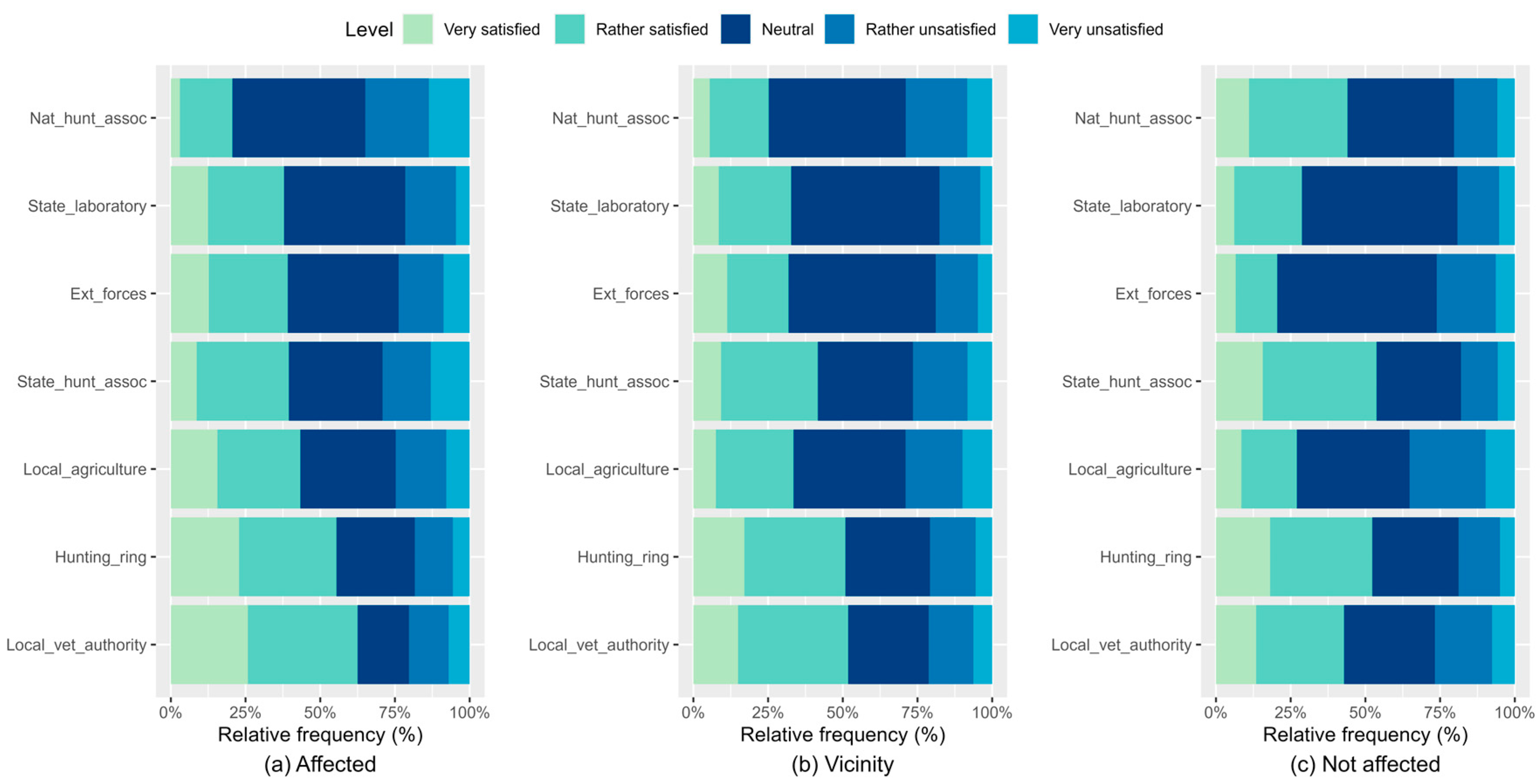
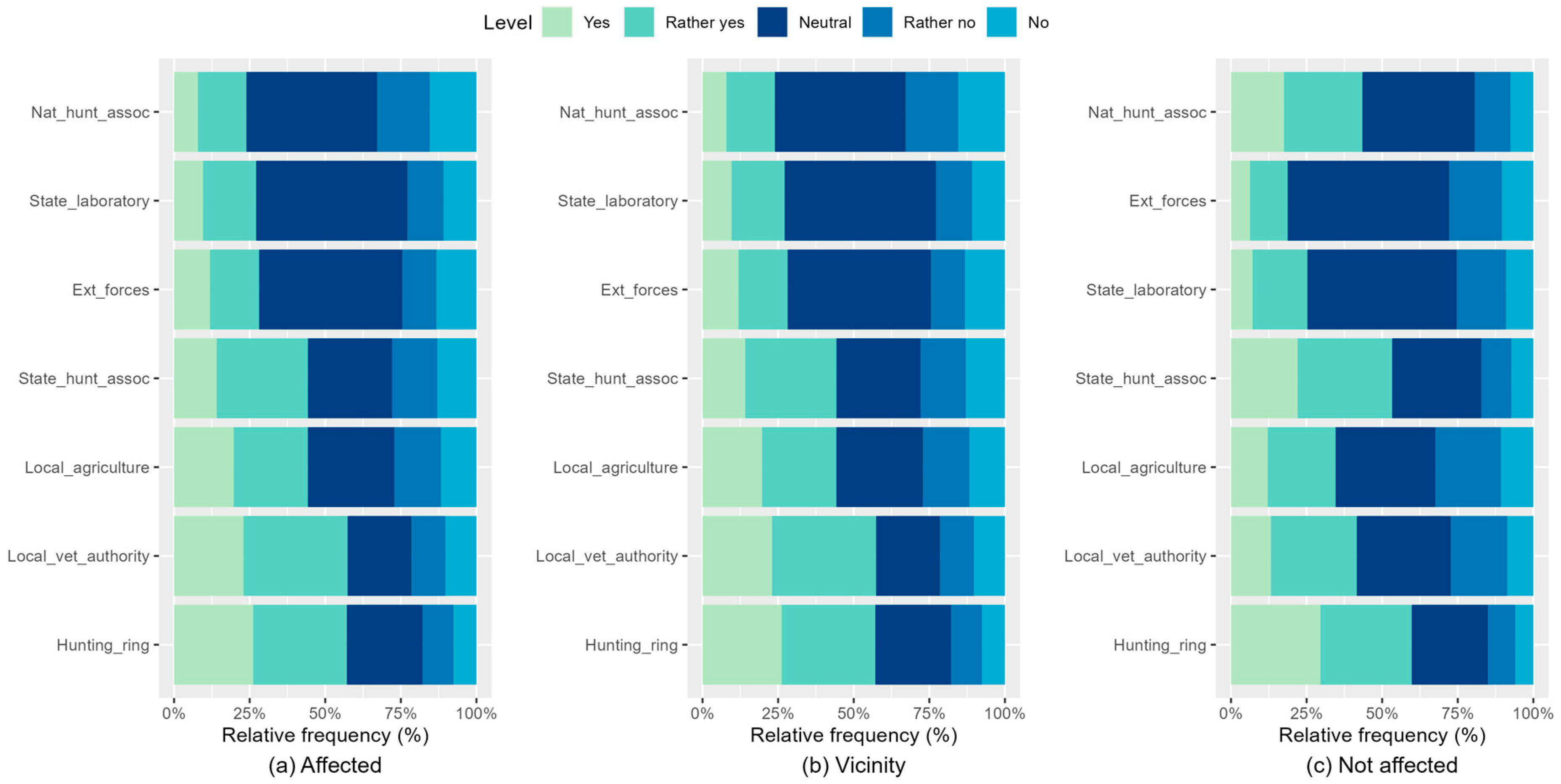
References
- Sánchez-Cordón, P.J.; Nunez, A.; Neimanis, A.; Wikström-Lassa, E.; Montoya, M.; Crooke, H.; Gavier-Widén, D. African Swine Fever: Disease Dynamics in Wild Boar Experimentally Infected with ASFV Isolates Belonging to Genotype I and II. Viruses 2019, 11, 852. [Google Scholar] [CrossRef]
- Jurado, C.; Fernández-Carrión, E.; Mur, L.; Rolesu, S.; Laddomada, A.; Sánchez-Vizcaíno, J.M. Why is African swine fever still present in Sardinia? Transbound. Emerg. Dis. 2018, 65, 557–566. [Google Scholar] [CrossRef]
- Rowlands, R.J.; Michaud, V.; Heath, L.; Hutchings, G.; Oura, C.; Vosloo, W.; Dwarka, R.; Onashvili, T.; Albina, E.; Dixon, L.K. African swine fever virus isolate, Georgia, 2007. Emerg. Infect. Dis. 2008, 14, 1870–1874. [Google Scholar] [CrossRef]
- Sánchez-Vizcaíno, J.M.; Mur, L.; Martínez-López, B. African swine fever (ASF): Five years around Europe. Vet. Microbiol. 2013, 165, 45–50. [Google Scholar] [CrossRef]
- EFSA Panel on Animal Health and Welfare. Scientific Opinion on African swine fever. EFSA J. 2014, 12, 3628. [Google Scholar] [CrossRef]
- Oļševskis, E.; Guberti, V.; Seržants, M.; Westergaard, J.; Gallardo, C.; Rodze, I.; Depner, K. African swine fever virus introduction into the EU in 2014: Experience of Latvia. Res. Vet. Sci. 2016, 105, 28–30. [Google Scholar] [CrossRef]
- Vilem, A.; Nurmoja, I.; Niine, T.; Riit, T.; Nieto, R.; Viltrop, A.; Gallardo, C. Molecular Characterization of African Swine Fever Virus Isolates in Estonia in 2014–2019. Pathogens 2020, 9, 582. [Google Scholar] [CrossRef]
- European Food Safety Authority; Desmecht, D.; Gerbier, G.; Gortázar Schmidt, C.; Grigaliuniene, V.; Helyes, G.; Kantere, M.; Korytarova, D.; Linden, A.; Miteva, A.; et al. Epidemiological analysis of African swine fever in the European Union (September 2019 to August 2020). EFSA J. 2021, 19, e06572. [Google Scholar] [CrossRef]
- Mazur-Panasiuk, N.; Walczak, M.; Juszkiewicz, M.; Woźniakowski, G. The Spillover of African Swine Fever in Western Poland Revealed Its Estimated Origin on the Basis of O174L, K145R, MGF 505-5R and IGR I73R/I329L Genomic Sequences. Viruses 2020, 12, 1084. [Google Scholar] [CrossRef]
- Sauter-Louis, C.; Forth, J.H.; Probst, C.; Staubach, C.; Hlinak, A.; Rudovsky, A.; Holland, D.; Schlieben, P.; Göldner, M.; Schatz, J.; et al. Joining the club: First detection of African swine fever in wild boar in Germany. Transbound. Emerg. Dis. 2021, 64, 1544–1752. [Google Scholar] [CrossRef]
- Chenais, E.; Ståhl, K.; Guberti, V.; Depner, K. Identification of Wild Boar-Habitat Epidemiologic Cycle in African Swine Fever Epizootic. Emerg. Infect. Dis. 2018, 24, 810–812. [Google Scholar] [CrossRef]
- Chenais, E.; Depner, K.; Guberti, V.; Dietze, K.; Viltrop, A.; Ståhl, K. Epidemiological considerations on African swine fever in Europe 2014–2018. Porcine Health Manag. 2019, 5, 6. [Google Scholar] [CrossRef]
- Taylor, R.A.; Podgórski, T.; Simons, R.R.L.; Ip, S.; Gale, P.; Kelly, L.A.; Snary, E.L. Predicting spread and effective control measures for African swine fever– should we blame the boars? Transbound. Emerg. Dis. 2021, 68, 397–416. [Google Scholar] [CrossRef] [PubMed]
- Kees van Dooren. ASF Germany: Brandenburg Asks for Restriction Zones to be Lifted. Pig Progress [Online], 6 June 2023. Available online: https://www.pigprogress.net/health-nutrition/health/brandenburg-asks-for-african-swine-fever-zones-to-be-lifted/ (accessed on 5 July 2023).
- Landkreis Ludwigslust-Parchim. Gemeinsamer Einsatz gegen Ausbreitung der Afrikanischen Schweinepest zeigt Wirkung: Gemeinsame Pressemitteilung mit dem Ministerium für Klimaschutz, Landwirtschaft, ländliche Räume und Umwelt Mecklenburg-Vorpommern. Available online: https://www.kreis-lup.de/Verwaltung/%C3%9Cber-uns/Wer-macht-was-/Fachdienst-Veterin%C3%A4r-und-Lebensmittel%C3%BCberwachung/Tierseuchenschutz/Afrikanische-Schweinepest/index.php?La=1&object=tx,3378.11366.1&kuo=2&sub=0 (accessed on 5 July 2023).
- Mačiulskis, P.; Masiulis, M.; Pridotkas, G.; Buitkuvienė, J.; Jurgelevičius, V.; Jacevičienė, I.; Zagrabskaitė, R.; Zani, L.; Pilevičienė, S. The African Swine Fever Epidemic in Wild Boar (Sus scrofa) in Lithuania (2014–2018). Vet. Sci. 2020, 7, 15. [Google Scholar] [CrossRef]
- Śmietanka, K.; Woźniakowski, G.; Kozak, E.; Niemczuk, K.; Frączyk, M.; Bocian, Ł.; Kowalczyk, A.; Pejsak, Z. African Swine Fever Epidemic, Poland, 2014–2015. Emerg. Infect. Dis. 2016, 22, 1201–1207. [Google Scholar] [CrossRef] [PubMed]
- EFSA Panel on Animal Health and Welfare. Scientific opinion on African swine fever. EFSA J. 2015, 13, 16. [Google Scholar] [CrossRef]
- Guinat, C.; Vergne, T.; Jurado-Diaz, C.; Sánchez-Vizcaíno, J.M.; Dixon, L.; Pfeiffer, D.U. Effectiveness and practicality of control strategies for African swine fever: What do we really know? Vet. Rec. 2017, 180, 97. [Google Scholar] [CrossRef]
- Calba, C.; Antoine-Moussiaux, N.; Charrier, F.; Hendrikx, P.; Saegerman, C.; Peyre, M.; Goutard, F.L. Applying participatory approaches in the evaluation of surveillance systems: A pilot study on African swine fever surveillance in Corsica. Prev. Vet. Med. 2015, 122, 389–398. [Google Scholar] [CrossRef]
- Vergne, T.; Guinat, C.; Petkova, P.; Gogin, A.; Kolbasov, D.; Blome, S.; Molia, S.; Pinto Ferreira, J.; Wieland, B.; Nathues, H.; et al. Attitudes and Beliefs of Pig Farmers and Wild Boar Hunters Towards Reporting of African Swine Fever in Bulgaria, Germany and the Western Part of the Russian Federation. Transbound. Emerg. Dis. 2016, 63, e194–e204. [Google Scholar] [CrossRef]
- Chenais, E.; Lewerin, S.S.; Boqvist, S.; Ståhl, K.; Alike, S.; Nokorach, B.; Emanuelson, U. Smallholders’ perceptions on biosecurity and disease control in relation to African swine fever in an endemically infected area in Northern Uganda. BMC Vet. Res. 2019, 15, 279. [Google Scholar] [CrossRef]
- Urner, N.; Sauter-Louis, C.; Staubach, C.; Conraths, F.J.; Schulz, K. A Comparison of Perceptions of Estonian and Latvian Hunters With Regard to the Control of African Swine Fever. Front. Vet. Sci. 2021, 8, 642126. [Google Scholar] [CrossRef] [PubMed]
- Urner, N.; Mõtus, K.; Nurmoja, I.; Schulz, J.; Sauter-Louis, C.; Staubach, C.; Conraths, F.J.; Schulz, K. Hunters’ Acceptance of Measures against African Swine Fever in Wild Boar in Estonia. Prev. Vet. Med. 2020, 182, 105121. [Google Scholar] [CrossRef] [PubMed]
- Urner, N.; Seržants, M.; Užule, M.; Sauter-Louis, C.; Staubach, C.; Lamberga, K.; Oļševskis, E.; Conraths, F.J.; Schulz, K. Hunters’ view on the control of African swine fever in wild boar. A participatory study in Latvia. Prev. Vet. Med. 2021, 186, 105229. [Google Scholar] [CrossRef]
- Stončiūtė, E.; Schulz, K.; Malakauskas, A.; Conraths, F.J.; Masiulis, M.; Sauter-Louis, C. What Do Lithuanian Hunters Think of African Swine Fever and Its Control-Perceptions. Animals 2021, 11, 525. [Google Scholar] [CrossRef] [PubMed]
- Stončiūtė, E.; Malakauskas, A.; Conraths, F.J.; Masiulis, M.; Sauter-Louis, C.; Schulz, K. The perceptions of Lithuanian hunters towards African swine fever using a participatory approach. BMC Vet. Res. 2022, 18, 401. [Google Scholar] [CrossRef] [PubMed]
- The R Foundation for Statistical Computing. R Studio 4.0.3. Available online: https://www.R-project.org/ (accessed on 5 July 2023).
- Wickham, H.; Averick, M.; Bryan, J.; Chang, W.; McGowan, L.; François, R.; Grolemund, G.; Hayes, A.; Henry, L.; Hester, J.; et al. Welcome to the Tidyverse. JOSS 2019, 4, 1686. [Google Scholar] [CrossRef]
- Wickham, H.; François, R.; Henry, L.; Müller, K. dplyr: A Grammar of Data Manipulation. Available online: https://dplyr.tidyverse.org; https://github.com/tidyverse/dplyr (accessed on 5 July 2023).
- Wickham, H. ggplot2: Elegant Graphics for Data Analysis, 2nd ed.; Springer: New York, NY, USA, 2016; ISBN 978-3-319-24277-4. [Google Scholar]
- ATLAS. ti. ATLAS.ti 22; Scientific Software Development GmbH: Berlin, Germany, 2022. [Google Scholar]
- Deutscher Jagdverband e.V. (DJV). Jagd Wird Weiblicher und Jünger, Berlin, 2022. Available online: https://www.jagdverband.de/jagd-wird-weiblicher-und-juenger (accessed on 5 July 2023).
- Glaser, B.G.; Strauss, A.L. The Discovery of Grounded Theory: Strategies for Qualitative Research, 3rd ed.; Aldine Transaction: New York, NY, USA, 1999; ISBN 978-0-202-30260-7. [Google Scholar]
- Saunders, B.; Sim, J.; Kingstone, T.; Baker, S.; Waterfield, J.; Bartlam, B.; Burroughs, H.; Jinks, C. Saturation in qualitative research: Exploring its conceptualization and operationalization. Qual. Quant. 2018, 52, 1893–1907. [Google Scholar] [CrossRef]
- Deutscher Jagdverband e.V. (DJV). Vergleich der Zahl der Jagdscheininhaber mit der Mitgliederzahl der LJV. In DJV-Handbuch Jagd 2021; Deutscher Jagdverband e.V. (DJV): Berlin, Germany, 2021. [Google Scholar]
- Oelke, J.; Müller, F.I.; Miggelbrink, J. The Urban Hunter in Times of African Swine Fever. Etnofoor 2022, 34, 67–88. [Google Scholar]
- Jori, F.; Chenais, E.; Boinas, F.; Busauskas, P.; Dholllander, S.; Fleischmann, L.; Oļševskis, E.; Rijks, J.M.; Schulz, K.; Thulke, H.-H.; et al. Application of the World Café method to discuss the efficiency of African swine fever control strategies in European wild boar (Sus scrofa) populations. Prev. Vet. Med. 2020, 185, 105178. [Google Scholar] [CrossRef]
- Broz, L.; Arregui, A.G.; O’Mahony, K. Wild Boar Events and the Veterinarization of Multispecies Coexistence. Front. Conserv. Sci. 2021, 2, 711299. [Google Scholar] [CrossRef]
- Essen, E.; Tickle, L. Leisure or Labour: An Identity Crisis for Modern Hunting? Sociologia Ruralis 2020, 60, 174–197. [Google Scholar] [CrossRef]
- Charvátová, P.; Wallo, R.; Jarosil, T.; Šatrán, P. How ASF was eradicated in the Czech Republic. Pig Prog. 2019. Available online: https://www.pigprogress.net/health-nutrition/how-asf-was-eradicated-in-the-czech-republic/ (accessed on 5 July 2023).
- Richter, M.; Schulz, K.; Elflein, T.; Achterberg, J.; Oļševskis, E.; Seržants, M.; Lamberga, K.; Conraths, F.J.; Sauter-Louis, C. The First Eighteen Months of African Swine Fever in Wild Boar in Saxony, Germany and Latvia-A Comparison. Pathogens 2023, 12, 87. [Google Scholar] [CrossRef]
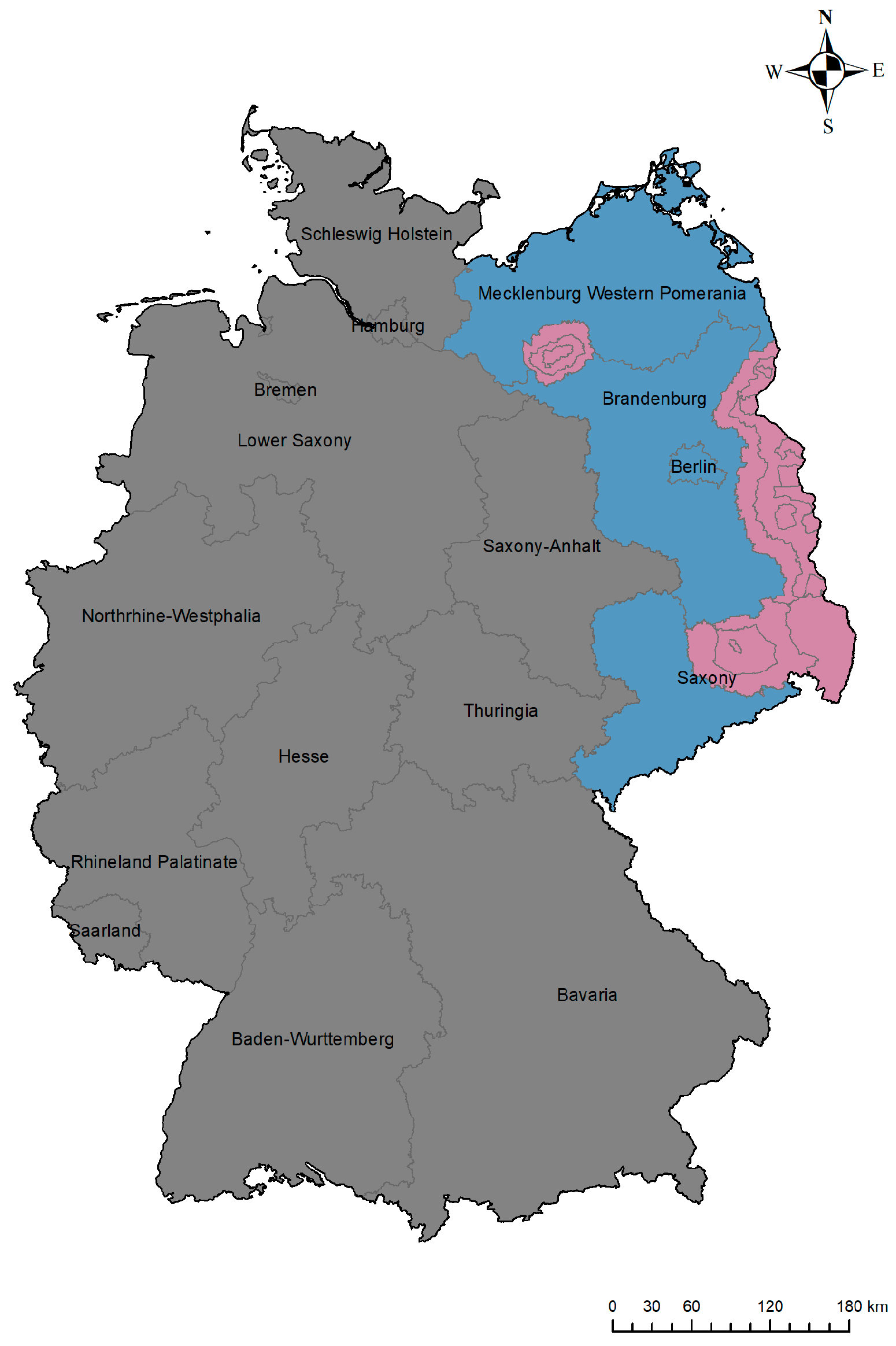
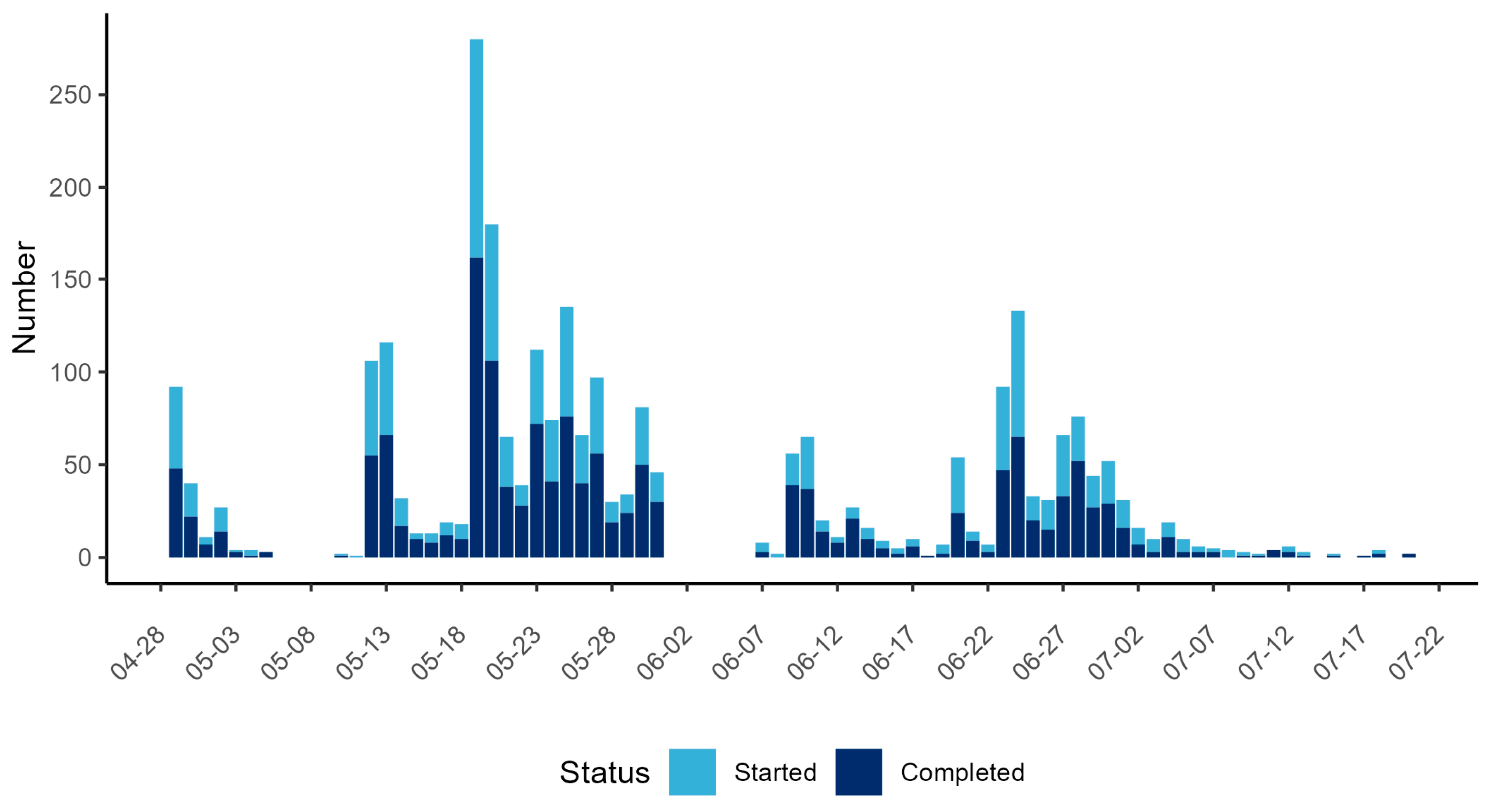
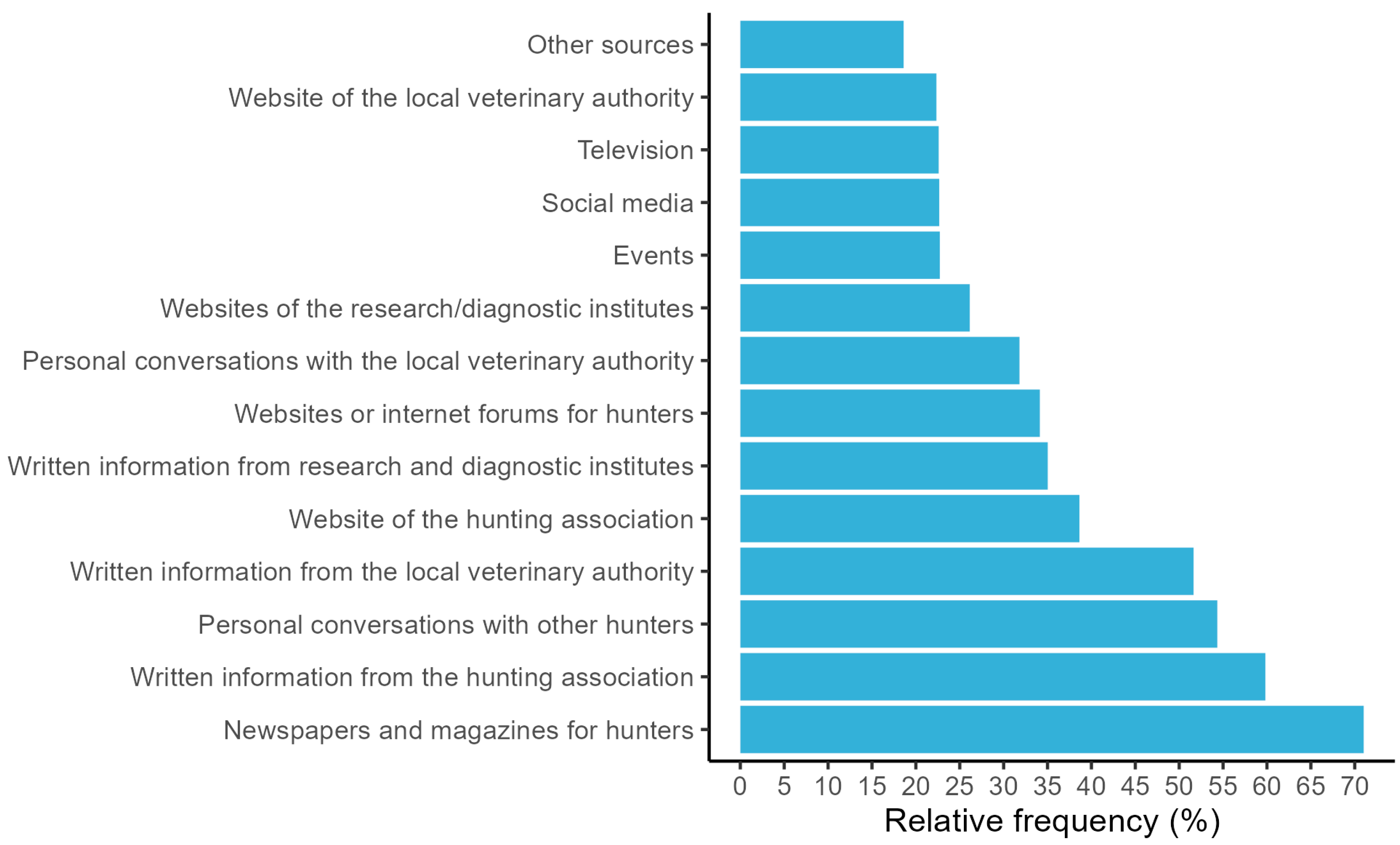
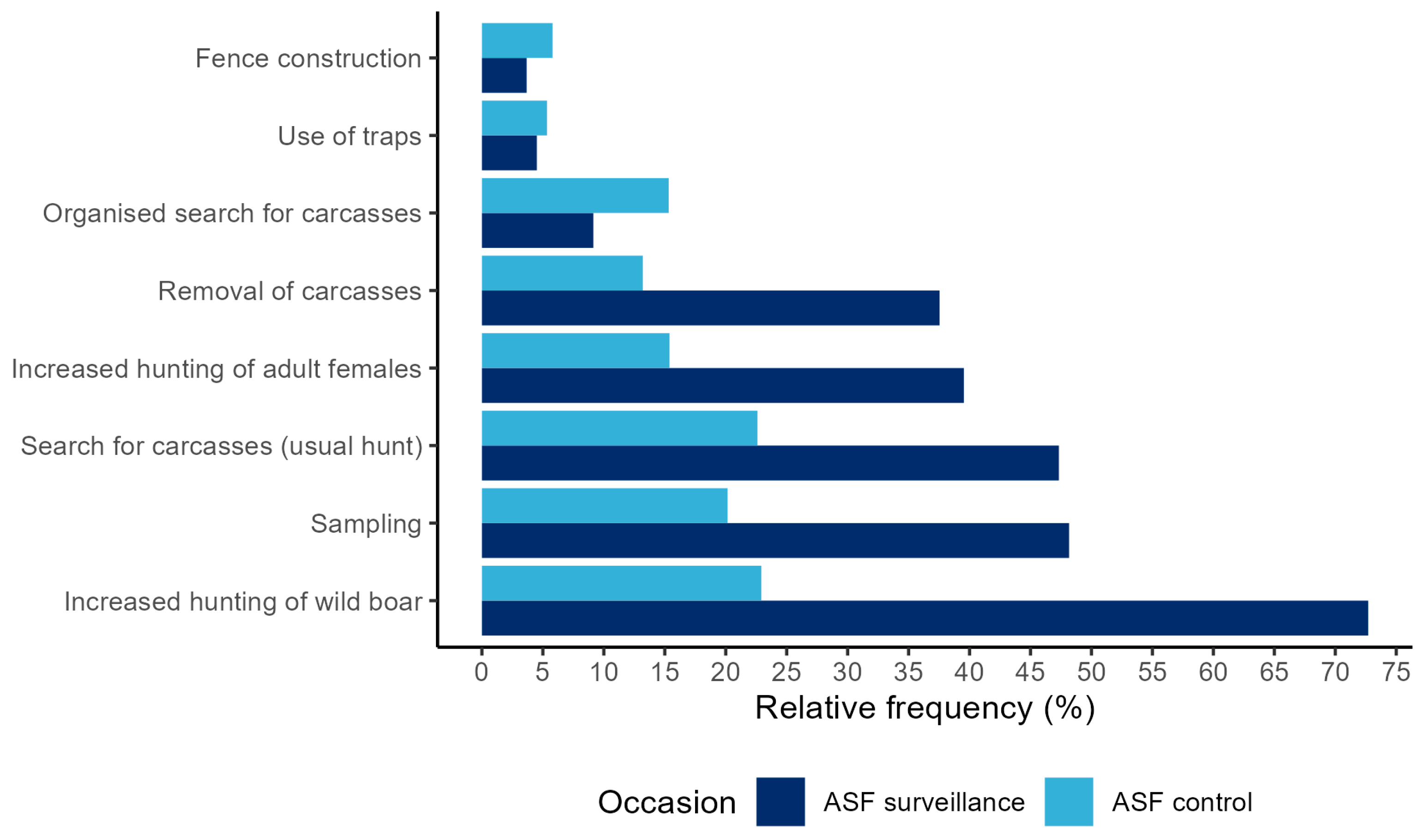
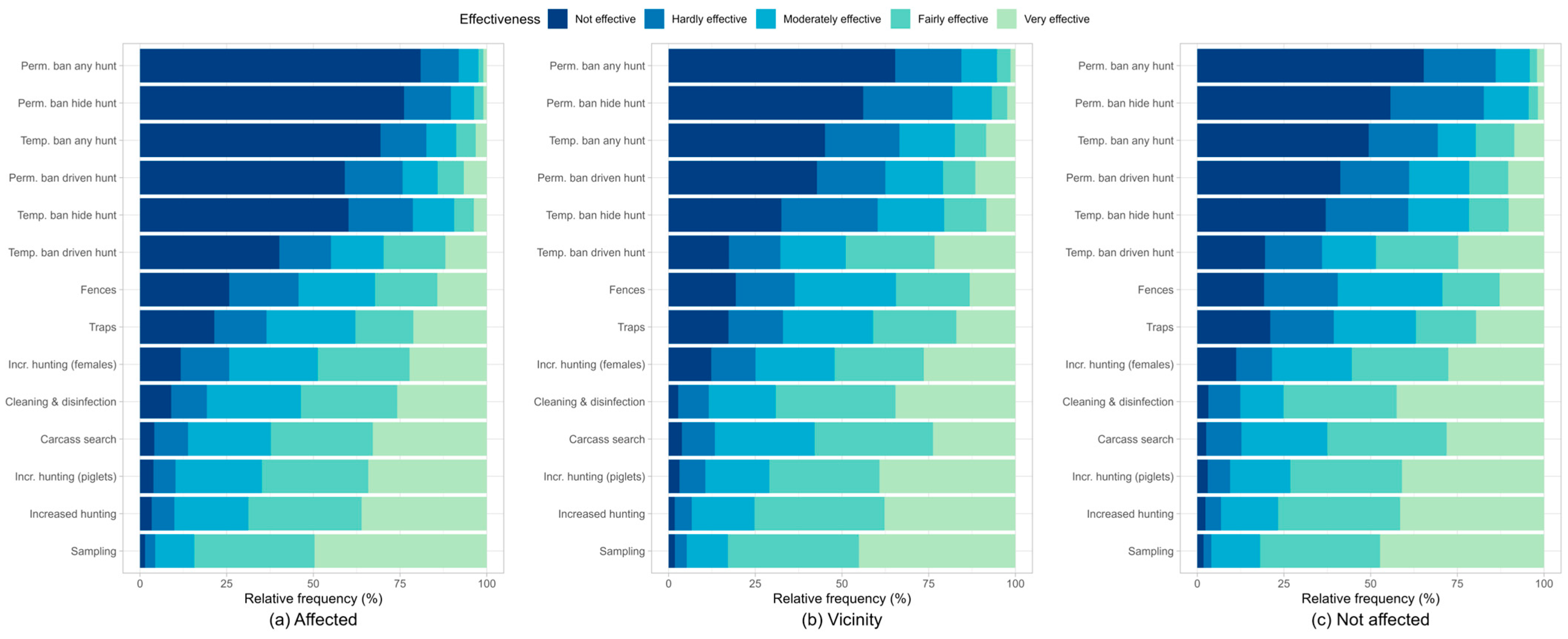
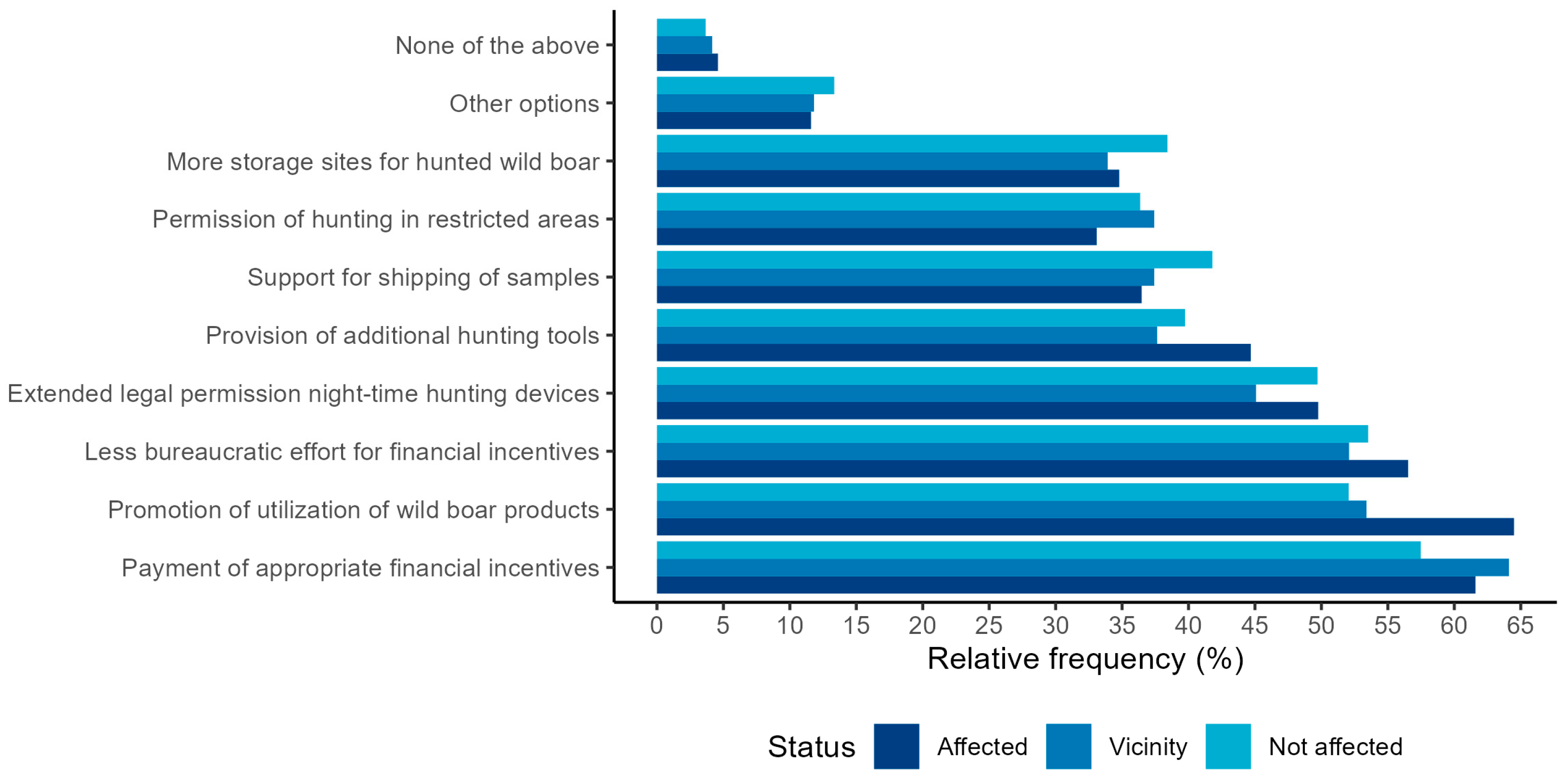
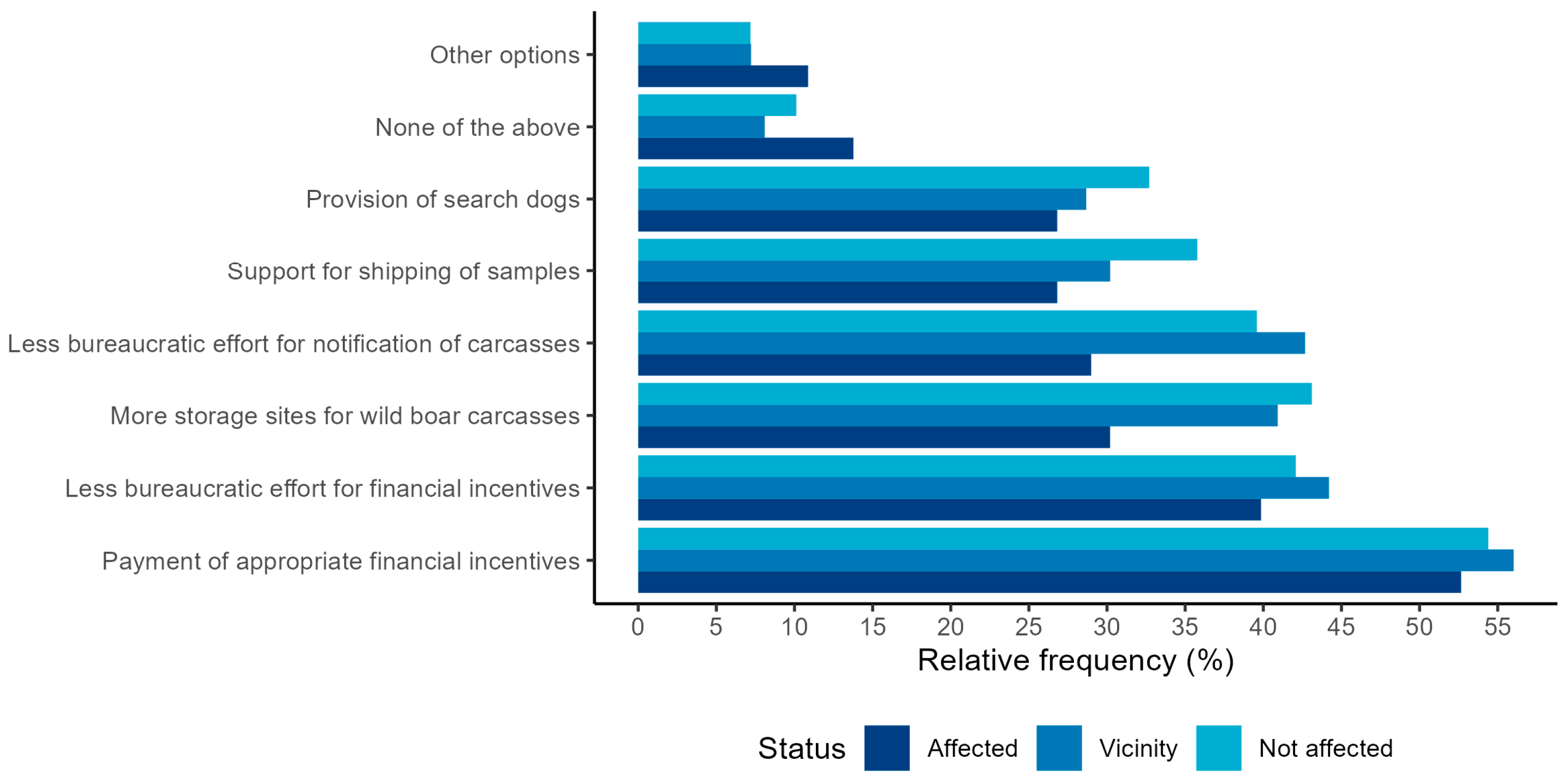
| Gender (%) | Age (%) | Hunting Experience (%) | |||
|---|---|---|---|---|---|
| Female | 12.1 | Under 20 Years | 1.5 | Under 3 Years | 5.7 |
| Male | 87.4 | 20 to 40 years | 27.9 | 3 to 10 years | 25.7 |
| Diverse | 0.5 | 41 to 60 years | 47.0 | 11 to 30 years | 40.2 |
| Over 60 years | 23.6 | Over 30 years | 28.4 | ||
| Affected (%) | Vicinity (%) | Not Affected (%) | |
|---|---|---|---|
| Less than 1 time | 4.8 | 4.8 | 8.9 |
| 1 to 5 times | 26.8 | 33.3 | 37.1 |
| 6 to 10 times | 33.1 | 34.1 | 29.6 |
| More than 10 times | 35.3 | 27.8 | 24.3 |
| Affected | Vicinity | Not Affected | ||||
|---|---|---|---|---|---|---|
| Median | Excluded (%) | Median | Excluded (%) | Median | Excluded (%) | |
| Sampling of wild boar (hunted or found dead) | 2 | 1.2 | 2 | 3.9 | 2 | 2.6 |
| Increased hunting of wild boar | 2 | 0.2 | 2 | 2.0 | 2 | 1.8 |
| Increased hunting of young animals | 2 | 1.0 | 2 | 2.8 | 2 | 2.6 |
| Intensive search for and removal of wild boar carcasses | 2 | 0.7 | 2 | 3.3 | 2 | 3.4 |
| Cleaning + disinfection of hunting equipment, clothing, and vehicles | 2 | 3.6 | 2 | 5.7 | 2 | 4.4 |
| Increased hunting of adult females | 3 | 3.4 | 2 | 3.9 | 2 | 4.8 |
| Use of wild boar traps | 3 | 13.3 | 3 | 16.4 | 3 | 19.9 |
| Construction of fences | 3 | 3.4 | 3 | 8.5 | 3 | 9.5 |
| Temporary ban on driven hunts after ASF outbreak | 4 | 2.7 | 3 | 7.0 | 3 | 6.3 |
| Temporary ban on hide hunting after ASF outbreak | 5 | 2.4 | 4 | 8.5 | 4 | 9.4 |
| Permanent ban on driven hunts after ASF outbreak | 5 | 1.4 | 4 | 9.0 | 4 | 7.6 |
| Temporary ban on any hunting activity after ASF outbreak | 5 | 1.4 | 4 | 6.3 | 4 | 5.7 |
| Permanent ban on hide hunting after ASF outbreak | 5 | 1.7 | 5 | 7.2 | 5 | 7.9 |
| Permanent ban on any hunting activity after ASF outbreak | 5 | 1.2 | 5 | 5.9 | 5 | 5.3 |
| Affected (%) | Vicinity (%) | Not Affected (%) | |
|---|---|---|---|
| Reduction in the wild boar population in the hunting area | 78.0 | 71.6 | 69.6 |
| Increased personal work and time load | 73.4 | 73.7 | 78.9 |
| Increased personal costs | 60.9 | 53.8 | 55.0 |
| Local restrictions of own hunting activity | 54.1 | 47.5 | 51.3 |
| Increase in own hunting activity (single hunt) | 40.6 | 56.7 | 58.2 |
| Reduction in own hunting activity (single hunt) | 38.6 | 22.1 | 22.6 |
| Conflicts with other hunters | 20.5 | 22.5 | 19.1 |
| Conflicts with farmers | 17.6 | 23.0 | 32.1 |
| Conflicts with veterinary authorities | 21.5 | 19.9 | 21.4 |
| Other consequences | 14.0 | 7.7 | 8.1 |
| No consequences | 1.7 | 3.3 | 4.3 |
| Satisfaction | Appreciation | |||||
|---|---|---|---|---|---|---|
| Median | No Coop. (%) | No Spec. (%) | Median | No Coop. (%) | No Spec. (%) | |
| Local veterinary authority | 2 | 2.7 | 0.7 | 2 | 1.7 | 3.6 |
| Hunting ring | 2 | 6.5 | 2.4 | 2 | 5.3 | 5.1 |
| State laboratory | 3 | 11.6 | 8.7 | 3 | 9.9 | 11.8 |
| External forces | 3 | 21.0 | 6.8 | 3 | 18.6 | 10.1 |
| Local agriculture | 3 | 10.4 | 2.7 | 3 | 6.3 | 5.3 |
| State hunting association | 3 | 13.0 | 3.1 | 3 | 10.9 | 6.8 |
| National hunting association | 3 | 21.5 | 5.8 | 3 | 17.1 | 9.2 |
| Satisfaction | Appreciation | |||||
|---|---|---|---|---|---|---|
| Median | No Coop. (%) | No Spec. (%) | Median | No Coop. (%) | No Spec. (%) | |
| Local veterinary authority | 2 | 5.0 | 4.2 | 3 | 5.0 | 8.3 |
| Hunting ring | 2 | 7.2 | 5.5 | 2 | 4.6 | 7.9 |
| State laboratory | 3 | 17.3 | 10.5 | 3 | 14.9 | 13.1 |
| External forces | 3 | 23.6 | 12.5 | 3 | 20.1 | 16.6 |
| Local agriculture | 3 | 10.9 | 7.4 | 3 | 7.9 | 8.3 |
| State hunting association | 3 | 10.5 | 4.4 | 3 | 7.9 | 7.4 |
| National hunting association | 3 | 15.8 | 7.9 | 3 | 12.7 | 9.2 |
| Satisfaction | Appreciation | |||||
|---|---|---|---|---|---|---|
| Median | No Coop. (%) | No Spec. (%) | Median | No Coop. (%) | No Spec. (%) | |
| Local veterinary authority | 3 | 8.9 | 5.9 | 3 | 7.9 | 6.5 |
| Hunting ring | 2 | 5.9 | 5.0 | 2 | 5.0 | 5.7 |
| State laboratory | 3 | 22.1 | 10.6 | 3 | 19.2 | 10.6 |
| External forces | 3 | 26.7 | 15.4 | 3 | 24.6 | 14.4 |
| Local agriculture | 3 | 13.3 | 7.0 | 3 | 9.2 | 6.0 |
| State hunting association | 2 | 7.8 | 4.1 | 2 | 6.0 | 5.4 |
| National hunting association | 3 | 12.8 | 6.3 | 3 | 9.7 | 7.3 |
Disclaimer/Publisher’s Note: The statements, opinions and data contained in all publications are solely those of the individual author(s) and contributor(s) and not of MDPI and/or the editor(s). MDPI and/or the editor(s) disclaim responsibility for any injury to people or property resulting from any ideas, methods, instructions or products referred to in the content. |
© 2023 by the authors. Licensee MDPI, Basel, Switzerland. This article is an open access article distributed under the terms and conditions of the Creative Commons Attribution (CC BY) license (https://creativecommons.org/licenses/by/4.0/).
Share and Cite
Rogoll, L.; Schulz, K.; Conraths, F.J.; Sauter-Louis, C. African Swine Fever in Wild Boar: German Hunters’ Perception of Surveillance and Control—A Questionnaire Study. Animals 2023, 13, 2813. https://doi.org/10.3390/ani13182813
Rogoll L, Schulz K, Conraths FJ, Sauter-Louis C. African Swine Fever in Wild Boar: German Hunters’ Perception of Surveillance and Control—A Questionnaire Study. Animals. 2023; 13(18):2813. https://doi.org/10.3390/ani13182813
Chicago/Turabian StyleRogoll, Lisa, Katja Schulz, Franz J. Conraths, and Carola Sauter-Louis. 2023. "African Swine Fever in Wild Boar: German Hunters’ Perception of Surveillance and Control—A Questionnaire Study" Animals 13, no. 18: 2813. https://doi.org/10.3390/ani13182813
APA StyleRogoll, L., Schulz, K., Conraths, F. J., & Sauter-Louis, C. (2023). African Swine Fever in Wild Boar: German Hunters’ Perception of Surveillance and Control—A Questionnaire Study. Animals, 13(18), 2813. https://doi.org/10.3390/ani13182813






